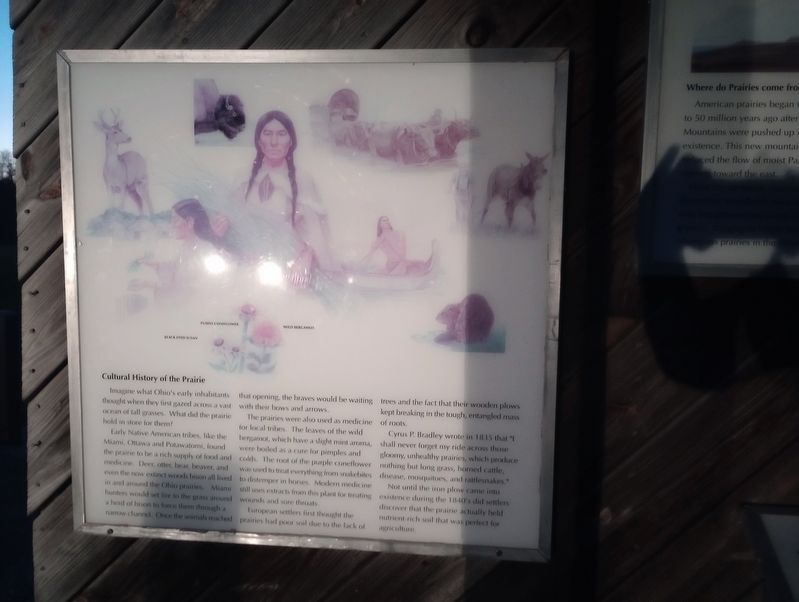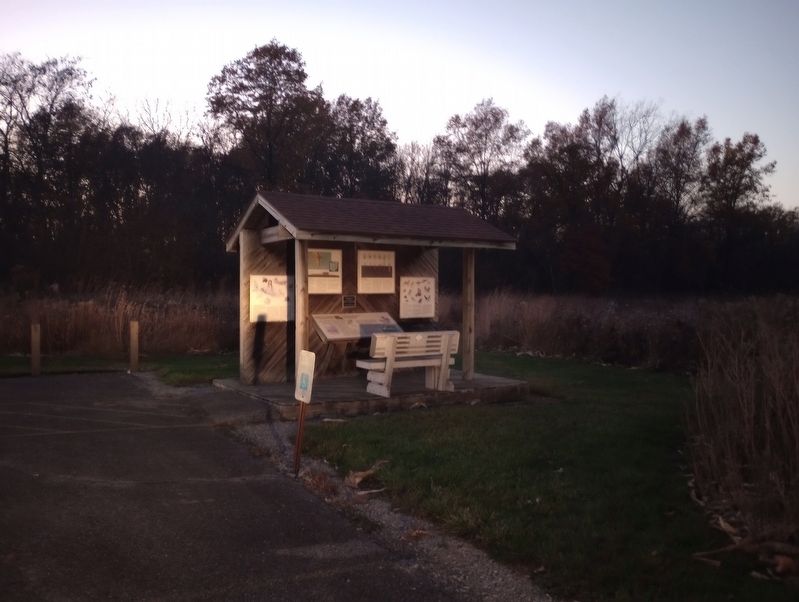Amanda Township in Hartford in Allen County, Ohio — The American Midwest (Great Lakes)
Cultural History of the Prairie
Early Native American tribes, like the Miami, Ottawa and Potawatomi, found the prairie to be a rich supply of food and medicine. Deer, otter, bear, beaver, and even the now extinct woods bison all lived in and around the Ohio prairies. Miami hunters would set fire to the grass around a herd of bison to force them through a narrow channel. Once the animals reached that opening, the braves would be waiting that opening, the braves would be waiting with their bows and arrows.
The prairies were also used as medicine for local tribes. The leaves of the wild bergamot, which have a slight mint aroma, were boiled as a cure for pimples and colds. The root of the purple coneflower was used to treat everything from snakebites to distemper in horses. Modern medicine still uses extracts from this plant for treating wounds and sore throats.
European settlers first thought the prairies had poor soil due to the lack of trees and the fact that their wooden plows kept breaking in the tough, entangled mass of roots.
Cyrus P. Bradley wrote in 1835 that "I shall never forget my ride across those nothing but long grass, horned cattle, gloomy, unhealthy prairies, which produce disease, mosquitoes, and rattlesnakes." existence during the 1840's did settlers Not until the iron plow came into discover that the prairie actually held nutrient-rich soil that was perfect for agriculture.
Erected by Johnny Appleseed Metropolitan Park District.
Topics. This historical marker is listed in these topic lists: Agriculture • Native Americans • Science & Medicine. A significant historical year for this entry is 1835.
Location. 40° 44.629′ N, 84° 19.15′ W. Marker is in Hartford, Ohio, in Allen County. It is in Amanda Township. Marker is on Defiance Trail North, on the left when traveling north. Touch for map. Marker is at or near this postal address: 500 Defiance Trail North, Spencerville OH 45887, United States of America. Touch for directions.
Other nearby markers. At least 8 other markers are within 3 miles of this marker, measured as the crow flies. Where do Prairies come from? (here, next to this marker); Welcome to Kiracofe Prairie! (here, next to this marker); Hartford Cemetery Veterans Memorial (approx. 0.3 miles away); Trail Designations (approx. 1.7 miles away); Recreation Along The Canal (approx. 1.7 miles away); Robert K. Antibus Trail Access (approx. 1.7 miles away); "Johnny Appleseed" (approx. 2.3 miles away); POW-MIA Still Missing / Wake Up America (approx. 2.7 miles away). Touch for a list and map of all markers in Hartford.
Credits. This page was last revised on November 27, 2023. It was originally submitted on November 20, 2023, by Craig Doda of Napoleon, Ohio. This page has been viewed 47 times since then and 14 times this year. Photos: 1, 2. submitted on November 20, 2023, by Craig Doda of Napoleon, Ohio. • Andrew Ruppenstein was the editor who published this page.

